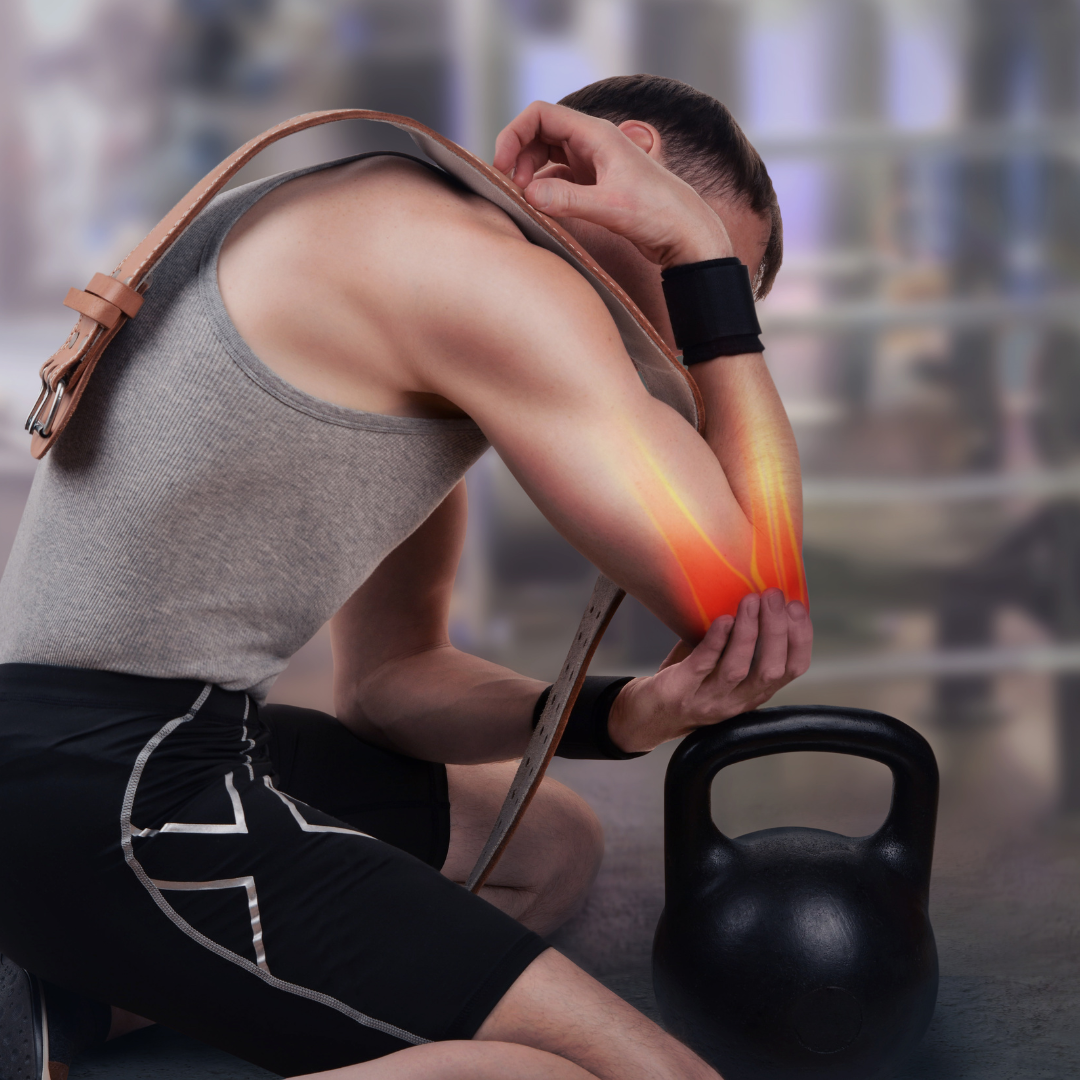Introduction
Whether you lift weights, play sports, swing a racquet, or work at a keyboard all day — you’re not immune to tennis elbow or golfer’s elbow.
These injuries aren’t limited to athletes. They’re two of the most common overuse tendon injuries, affecting the forearm muscles that attach at the elbow. The pain can be sharp, annoying, stubborn, and if you ignore it… it sticks around.
The good news? You can fix it. And most people can get back to lifting, training, or playing pain-free with smart rehab and gradual loading.
1. What’s the Difference?
Tennis elbow and golfer’s elbow are cousins — same joint, different side.
Tennis Elbow (Lateral Epicondylitis)
-
Pain on the outside of the elbow
-
Overuse of wrist extensors
-
Common in: tennis players, lifters, mechanics, painters, computer users
-
Movements that hurt: gripping, pulling, lifting a cup, rows, deadlifts
Golfer’s Elbow (Medial Epicondylitis)
-
Pain on the inside of the elbow
-
Overuse of wrist flexors & pronators
-
Common in: golfers, baseball players, weightlifters, manual workers
-
Movements that hurt: gripping, curls, pressing, throwing
Both injuries = tiny microscopic tears in the tendon from chronic stress → inflammation → tendon degeneration.
2. Symptoms to Look Out For
Tennis Elbow Symptoms:
-
Pain or burning on the outside of the elbow
-
Tenderness when pressing on the bony bump (lateral epicondyle)
-
Pain with gripping, shaking hands, lifting objects palm-down
-
Weak grip strength
Golfer’s Elbow Symptoms:
-
Pain or tightness on the inside of the elbow
-
Pain when curling, throwing, or squeezing
-
Stiff forearm
-
Weakness in wrist flexion
Both may include:
-
Aching during or after workouts
-
Pain during gripping, typing, or carrying bags
-
Symptoms worse in the morning
3. What Causes It?
Both conditions are caused by overuse + poor recovery, not one dramatic injury.
Main causes include:
-
Repetitive gripping
-
Too much volume too fast
-
Weak wrist/forearm muscles
-
Tight forearms from lifting
-
Poor shoulder or scapular stability
-
Lack of deloads
-
Poor ergonomics or form
And yes — lifters get it a lot: especially from pull-ups, deadlifts, curls, rows, benching, and barbell work.
4. How to Fix Tennis & Golfer’s Elbow
Here’s the most effective, evidence-based approach:
Reduce the Movements Causing Sharp Pain
Don’t stop training — just adjust.
Swap these temporarily:
-
Heavy barbell lifts → dumbbells or straps
-
Straight-bar curls → dumbbell or rope curls
-
Chin-ups → neutral-grip pull-ups
-
High-volume gripping → straps for heavy pulling days
Goal: reduce stress on the irritated tendon.
Apply Ice (Short-Term Relief)
10–15 minutes after aggravating activity.
This helps with short-term inflammation but does not fix the root problem.
Fix the Root: Strengthen & Rebuild the Tendon
Tendon rehab works in phases, and research shows the best results come from eccentric and isometric loading.
Best Exercises for Tennis Elbow (Lateral):
-
Eccentric wrist extensions
-
Tyler twist (Theraband flex bar)
-
Isometric wrist extension holds
-
Reverse curls
-
Farmer carries (light to moderate)
Best Exercises for Golfer’s Elbow (Medial):
-
Eccentric wrist flexion
-
Forearm pronation/supination
-
Isometric wrist flexion holds
-
Hammer curls (neutral grip)
-
Grip strengthening
Frequency:
3–5 sessions per week
8–12 min per session
Rule of thumb:
Mild discomfort = OK
Sharp pain = back off
Stretch the Forearms (But Don’t Overstretch)
Tendons don’t like aggressive stretching.
Use gentle mobility:
-
Wrist flexor stretch: palm up, fingers pulled gently back
-
Wrist extensor stretch: palm down, fingers pulled back
-
20–30 seconds, 2–3x daily
Strengthen the Shoulder & Scapula
Weak shoulders force your forearms to compensate.
Add:
-
Face pulls
-
Scapular wall slides
-
External rotations
-
Rows
This stabilizes the kinetic chain → less elbow stress.
Gradual Return to Training
Once symptoms ease:
-
Reintroduce old lifts pain-free
-
Use higher reps + lighter weight initially
-
Increase load weekly by 5–10%
-
Continue forearm work even after you're “healed”
Most cases improve within 4–8 weeks if treated early; chronic cases can take 8–12+ weeks.
7. Prevention Tips
-
Warm up your wrists & forearms before heavy lifts
-
Strengthen the extensor/flexor muscles year-round
-
Use neutral grips more often
-
Keep elbows "stacked" during curls
-
Program deload weeks
-
Improve desk posture if you type all day
8. Key Takeaways
-
Tennis elbow = pain on the outside
-
Golfer’s elbow = pain on the inside
-
Both come from overuse, not sudden injury
-
The best fix = reduce load → strengthen tendons → restore mobility → rebuild
-
Most people can recover without stopping workouts entirely
-
Smart training + proper rehab keeps you in the game long-term
Read more

Learn the symptoms, causes, and treatment of weightlifter’s shoulder (distal clavicle osteolysis). Discover how to train smart, relieve pain, and prevent future flare-ups.

Maintain, Don’t Melt Down The holiday goal isn’t “new body in 2 weeks.” It’s don’t lose the progress you already earned and maybe tighten things up a bit. Guidelines from the CDC and AHA say adults...

